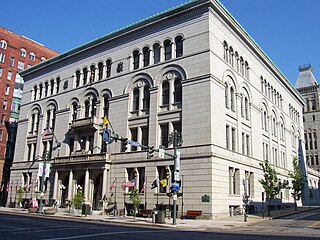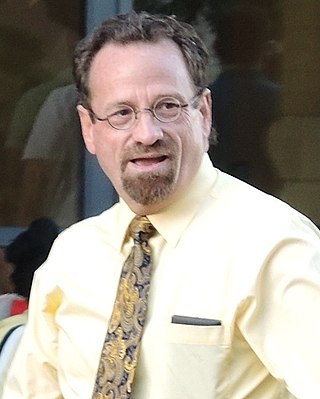Life
He was born on May 12, 1833, in Parma, Monroe County, New York, the son of Caleb Mapes and Harriet (Avery) Mapes. [1] He attended the common schools in Rochester. Then he became a machinist. He was active in the labor reform movement, and was Secretary of the Monroe County Working Men's General Assembly. [2]

Parma is a town in Monroe County, New York, United States. The population was 15,633 at the 2010 census.

Monroe County is a county in the western portion of the state of New York, in the United States. The county is along Lake Ontario's southern shore. As of 2017, Monroe County's population was 747,642. Its county seat is the city of Rochester. The county is named after James Monroe, the fifth President of the United States. Monroe County is part of the Rochester, NY Metropolitan Statistical Area.

Rochester is a city on the southern shore of Lake Ontario in western New York. With a population of 208,046 residents, Rochester is the seat of Monroe County and the third most populous city in New York state, after New York City and Buffalo. The metropolitan area has a population of just over 1 million people. It is about 73 miles (117 km) east of Buffalo and 87 miles (140 km) west of Syracuse.
He also entered politics as a Whig, and joined the Republican Party upon its foundation. He left the party in 1870, and later ran in elections on independent and third-party tickets.

The Whig Party was a political party active in the middle of the 19th century in the United States. Four presidents belonged to the party while in office. It emerged in the 1830s as the leading opponent of Jacksonian democracy, pulling together former members of the National Republican and the Anti-Masonic Party. It had some links to the upscale traditions of the long-defunct Federalist Party. Along with the rival Democratic Party, it was central to the Second Party System from the early 1840s to the mid-1860s. It originally formed in opposition to the policies of President Andrew Jackson and his Democratic Party. It became a formal party within his second term, and slowly receded influence after 1854. In particular terms, the Whigs supported the supremacy of Congress over the presidency and favored a program of modernization, banking and economic protectionism to stimulate manufacturing. It appealed to entrepreneurs, planters, reformers and the emerging urban middle class, but had little appeal to farmers or unskilled workers. It included many active Protestants and voiced a moralistic opposition to the Jacksonian Indian removal. Party founders chose the "Whig" name to echo the American Whigs of the 18th century who fought for independence. The political philosophy of the American Whig Party was not related to the British Whig party. Historian Frank Towers has specified a deep ideological divide:

The Republican Party, also referred to as the GOP, is one of the two major political parties in the United States; the other is its historic rival, the Democratic Party.
In November 1870, he ran in the 28th District for Congress, and received 50 votes in the election to fill the vacancy in the 41st Congress, and 658 votes in the election for the seat in the 42nd Congress. [3]

The 28th district of New York is an obsolete congressional district for the United States House of Representatives. Before becoming obsolete in 2013, the district was based in Rochester, Buffalo, and Niagara Falls, and included parts of Erie, Monroe, Niagara and Orleans Counties. Its easternmost point was in Fairport at the home of its final representative, Democrat Louise Slaughter. Due to its gerrymandered shape it was sometimes known as "the earmuffs."
In November 1877, he was elected to the New York State Assembly, nominated by the Greenback Party, the Working Men, and other independent labor reform organizations. The Republicans made no nomination at that election, and Mapes polled 7,400 votes, 3,807 more than his Democratic opponent. [4] He was a member of the 101st New York State Legislature in 1878. [5]

The New York State Assembly is the lower house of the New York State Legislature, the New York State Senate being the upper house. There are 150 seats in the Assembly, with each of the 150 Assembly districts having an average population of 128,652. Assembly members serve two-year terms without term limits.
The Greenback Party was an American political party with an anti-monopoly ideology which was active between 1874 and 1889. The party ran candidates in three presidential elections—in the elections of 1876, 1880, and 1884, before fading away.

The 101st New York State Legislature, consisting of the New York State Senate and the New York State Assembly, met from January 1 to May 15, 1878, during the second year of Lucius Robinson's governorship, in Albany.
He died in 1906. [6]

Joseph D. Morelle is an American politician serving as the U.S. Representative for New York's 25th congressional district since 2018. He was formerly a member of the New York State Assembly representing the 136th Assembly District, which includes eastern portions of the City of Rochester and the Monroe County suburbs of Irondequoit and Brighton. Speaker Sheldon Silver appointed him as Majority Leader of the New York State Assembly in January 2013 and Morelle served as Acting Speaker in the Speaker's absence. He was elected to the United States House of Representatives for New York's 25th congressional district in November 2018 following the death of longtime Congresswoman Louise Slaughter.

August "Gus" Claessens was an American socialist politician, best known as one of the five New York Assemblymen expelled from that body during the First Red Scare for their membership in the Socialist Party of America.

The 1879 New York state election was held on November 4, 1879, to elect the Governor, the Lieutenant Governor, the Secretary of State, the State Comptroller, the Attorney General, the State Treasurer and the State Engineer, as well as all members of the New York State Assembly and the New York State Senate.
The 1809 United States Senate election in New York was held on February 7, 1809, by the New York State Legislature to elect a U.S. Senator to represent the State of New York in the United States Senate.
The 1831 United States Senate election in New York was held on February 1, 1831, by the New York State Legislature to elect a U.S. Senator to represent the State of New York in the United States Senate.
The 1833 United States Senate election in New York was held on February 5, 1833, by the New York State Legislature to elect a U.S. Senator to represent the State of New York in the United States Senate.
The 1857 United States Senate election in New York was held on February 3, 1857, by the New York State Legislature to elect a U.S. Senator to represent the State of New York in the United States Senate.
The United States Senate elections of 1856 and 1857 were elections which had the young Republican Party assume its position as one of the United States's two main political parties. The Whigs and Free Soilers were gone by the time the next Congress began.
The United States Senate elections of 1878 and 1879 were elections which had the Democratic Party retake control of the United States Senate for the first time since before the Civil War.

Harry B. Bronson is an attorney and politician from Rochester, New York who serves as a member of the New York State Assembly. A former member of the Monroe County legislature, he was elected to the Assembly in 2010. He is a Democrat.
The United States Senate elections of 1862 and 1863 were elections during the American Civil War in which Republicans increased their control of the U.S. Senate. The Republican Party gained three seats, bringing their majority to 66% of the body. Also caucusing with them were Unionists and Unconditional Unionists. As many Southern states seceded in 1860 and 1861, and members left the Senate to join the Confederacy, or were expelled for supporting the rebellion, seats were declared vacant. To establish a quorum with fewer members, a lower total seat number was taken into account.

The 45th New York State Legislature, consisting of the New York State Senate and the New York State Assembly, met from January 2 to April 17, 1822, during the fifth year of DeWitt Clinton's governorship, in Albany.

The 46th New York State Legislature, consisting of the New York State Senate and the New York State Assembly, met from January 7 to April 24, 1823, during the first year of Joseph C. Yates's governorship, in Albany.

The 93rd New York State Legislature, consisting of the New York State Senate and the New York State Assembly, met from January 4 to April 26, 1870, during the second year of John T. Hoffman's governorship, in Albany.

The 130th New York State Legislature, consisting of the New York State Senate and the New York State Assembly, met from January 2 to July 26, 1907, during the first year of Charles Evans Hughes's governorship, in Albany.

The 131st New York State Legislature, consisting of the New York State Senate and the New York State Assembly, met from January 1 to June 11, 1908, during the second year of Charles Evans Hughes's governorship, in Albany.

The 134th New York State Legislature, consisting of the New York State Senate and the New York State Assembly, met from January 4 to October 6, 1911, during the first year of John Alden Dix's governorship, in Albany.

The 144th New York State Legislature, consisting of the New York State Senate and the New York State Assembly, met from January 5 to April 16, 1921, during the first year of Nathan L. Miller's governorship, in Albany.

The 162nd New York State Legislature, consisting of the New York State Senate and the New York State Assembly, met from January 4, 1939, to October 22, 1940, during the seventh and eight years of Herbert H. Lehman's governorship, in Albany.













